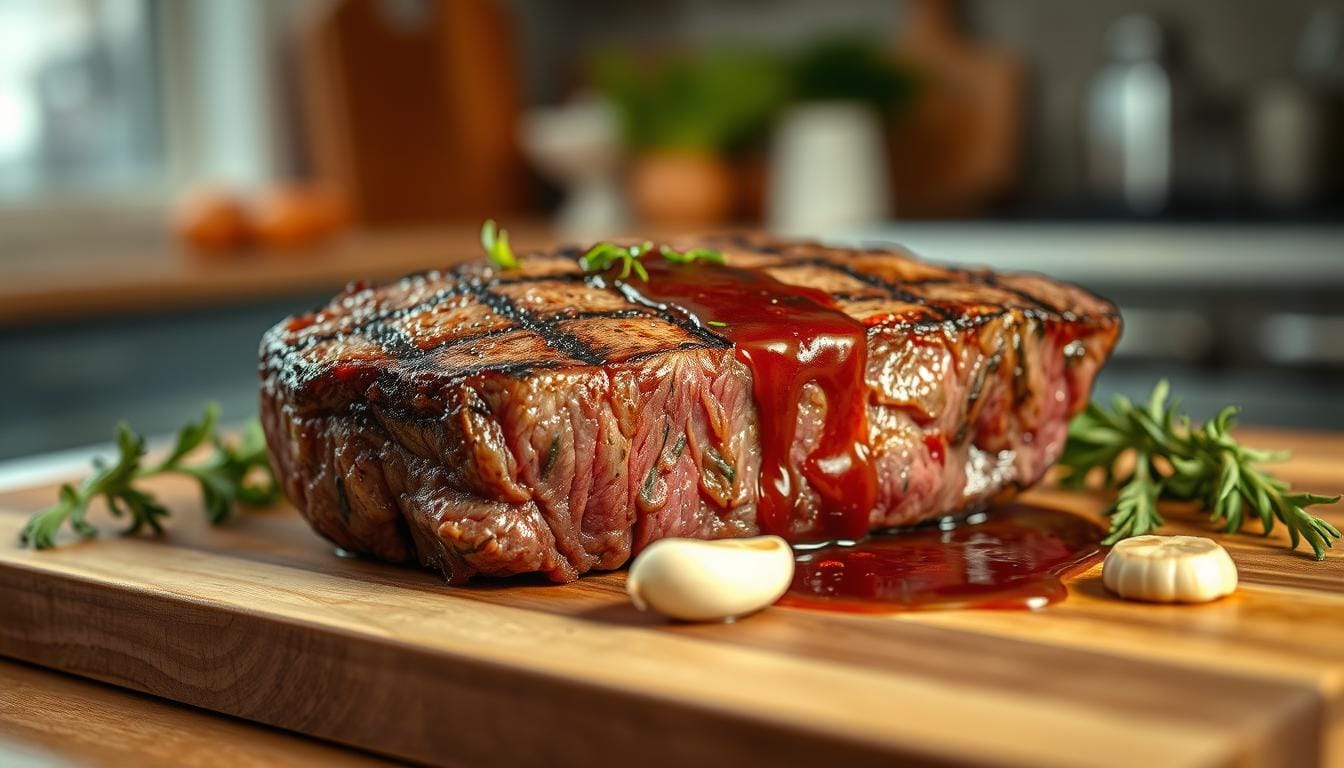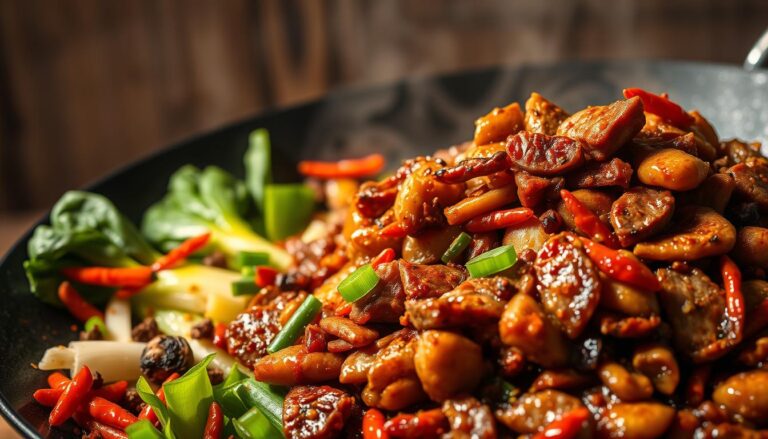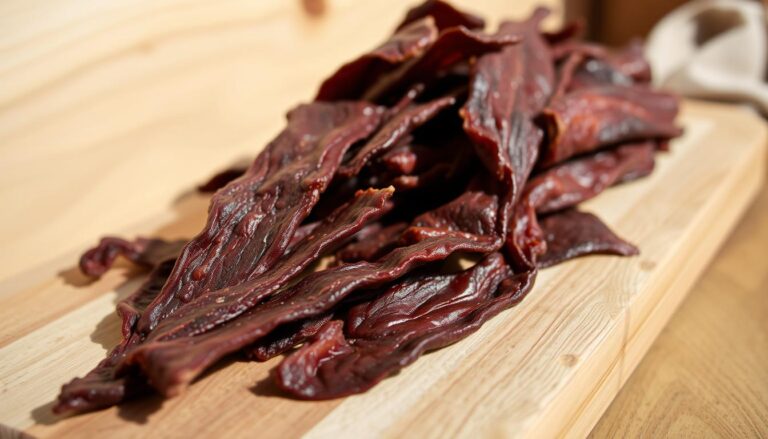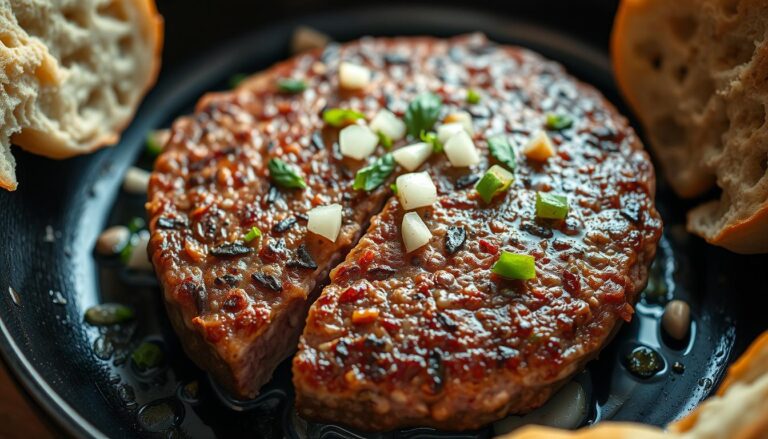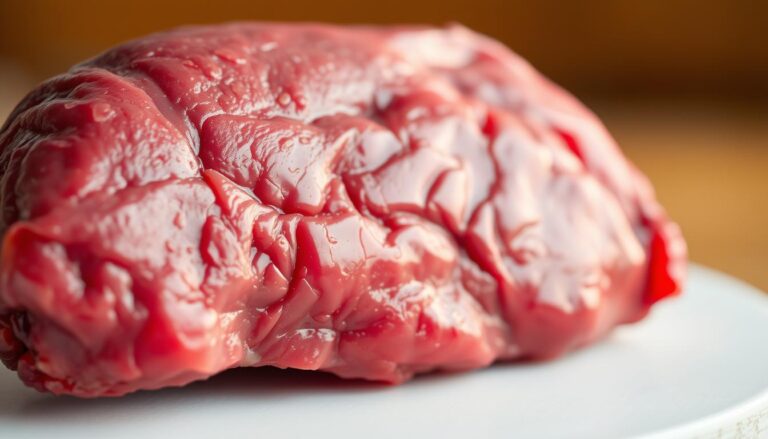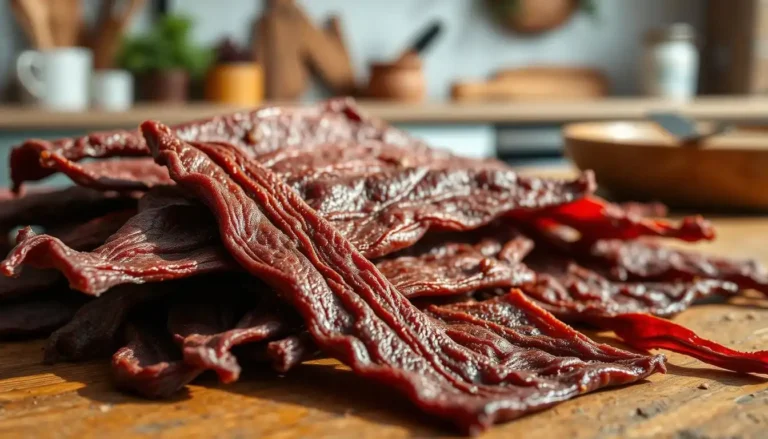Teres Major Steak Recipe: A Savory Dish You’ll Love
Table of Contents
Teres Major Steak Recipe: A Savory Dish You’ll Love
Get ready to uncover a culinary treasure: the teres major cut of beef, known as the “butcher’s secret.” This hidden treasure is as tender as filet mignon but costs less. It’s a delightful surprise for any meal.
So, what’s so special about this cut? Its tenderness and rich flavor set it apart. In this article, you’ll learn how to prepare, cook, and serve a delicious teres major steak. It’s sure to wow your family and friends.
Key Takeaways
- Discover the benefits of cooking teres major steak.
- Learn simple preparation methods for this cut of beef.
- Understand various cooking techniques to achieve perfection.
- Find serving suggestions to complement your dish.
- Explore tips for making your meal truly memorable.
What is Teres Major?
The Teres Major is a lesser-known beef cut from the cow’s shoulder, part of the chuck primal. It’s known for being very tender because it’s used less.
Understanding the Cut of Meat
Teres Major is also called the “petite tender” or “shoulder tender.” It’s a muscle that doesn’t work much, making it tender. You might need to ask your butcher for it, as it’s not common.
Looking for Teres Major can be tricky because of the “terrace major” mix-up. Remember, it comes from the chuck primal to find it right.
Characteristics of Teres Major
The Teres Major cut looks like a pork tenderloin and weighs 8-12 ounces. It’s known for its fine marbling and tender texture. This makes it a top choice for a tender steak.
- Tenderness: It’s almost as tender as the tenderloin.
- Size: It’s 10-12 inches long and 2-3 inches wide.
- Comparison: It’s like filet mignon and flat iron steak, giving a similar taste.
Knowing these traits helps you see why Teres Major is prized by steak lovers. It’s rare but worth it.
Why Choose Teres Major Steak?
The Teres Major steak is becoming a favorite among chefs and home cooks. It’s known for its rich flavor and tender texture. This cut of beef offers a unique culinary experience that’s both satisfying and indulgent.
Flavor Profile and Texture
The Teres Major steak has a rich, beefy flavor. It’s more flavorful than filet mignon but not as strong as ribeye or strip steak. Its fine marbling makes it juicy and flavorful while being lean overall.
This balance makes it perfect for those who want a tender steak without too much fat. The Teres Major steak is versatile for various cooking methods, from grilling to pan-searing. It’s great for any occasion, from special dinners to weeknight meals.
Health Benefits of Teres Major
Teres Major steak is not only delicious but also healthy. It’s a lean protein source, making it ideal for those watching their fat intake. A 3-ounce serving has about 22 grams of protein, 6 grams of fat, and is packed with iron, zinc, and B vitamins.
| Nutrient | Amount per 3 oz serving | % Daily Value |
|---|---|---|
| Protein | 22 grams | 44% |
| Fat | 6 grams | 9% |
| Iron | 2.5 mg | 14% |
| Zinc | 3.5 mg | 23% |
Adding Teres Major steak to your diet can help with muscle maintenance, immune function, and energy production. When eaten in moderation, it’s a healthy part of a balanced diet.
Ingredients for Teres Major Steak
To make a delicious Teres Major steak, you need some top-notch ingredients. The right stuff not only brings out the steak’s natural taste but also makes your meal enjoyable.
Essential Ingredients
The base of a tasty Teres Major steak recipe is the steak itself. Look for a cut that’s bright red and has good marbling. This makes the steak tender and flavorful. You’ll also need:
- Salt: Use kosher or sea salt for its coarser texture and cleaner taste.
- Pepper: Freshly ground pepper is key for the best flavor.
- High-heat cooking oil: Avocado oil, grapeseed oil, or clarified butter are great for searing.
- Optional aromatics: Garlic and herbs like rosemary and thyme can deepen the steak’s flavor.
| Ingredient | Purpose | Recommendation |
|---|---|---|
| Teres Major Steak | The main ingredient, providing the core flavor and texture. | Choose a bright red cut with good marbling. |
| Salt | Enhances the natural flavors of the steak. | Use kosher or sea salt. |
| Pepper | Adds a sharp, peppery flavor. | Grind it fresh for the best taste. |
| Cooking Oil | Used for searing the steak at high temperatures. | Avocado oil or clarified butter are good choices. |
Optional Marinades and Seasonings
To boost your Teres Major steak’s flavor, try marinades and seasonings. Simple marinades with olive oil, garlic, and herbs can add a rich taste. More complex marinades, like those with soy sauce, wine, or citrus, can create different flavors.
Marinating Times: Teres Major steak is tender, so it doesn’t need long marinating. A few hours or even 30 minutes can be enough, depending on the marinade’s strength and your taste.
If you prefer dry rubs, mix spices and herbs directly on the steak. Use classic steakhouse seasonings, herb blends, or spice mixes from different cuisines. The goal is to enhance the steak’s natural qualities without overpowering it.
How to Prepare Teres Major Steak
To make a delicious Teres Major steak, start with careful trimming and cleaning. This step is key to a great dining experience. It ensures the steak cooks evenly and looks good on your plate.
Trimming and Cleaning the Meat
Begin by trimming off any extra fat or silverskin from the steak. Use a sharp knife to remove these parts carefully. Make sure to know the meat’s grain direction. This will help you slice it right later.
Trimming Tips:
- Use a sharp knife for precise cuts.
- Take off any silverskin or extra fat.
- Don’t cut away too much meat.
After trimming, rinse the meat under cold water. Then, dry it with paper towels. This step is important for getting rid of fat and silverskin. It also helps in achieving a great sear when cooking.
Cooking Methods Overview
You can cook Teres Major steak in several ways, each with its own benefits. The main methods are grilling, pan-searing, and roasting. Your choice depends on your cooking gear, the steak’s doneness you want, and your taste.
Grilling is perfect for a charred outside and smoky taste. It needs a hot grill and careful timing to get the steak just right.
Pan-searing gives a crispy crust on the steak. Heat a skillet very hot and cook the steak for a few minutes on each side.
Roasting in the oven is easy and good for even cooking. Season the steak and bake it in a hot oven.
No matter the method, let the steak come to room temperature before cooking. Pat it dry to improve the cooking results.
Grilling Teres Major Steak
To get a perfectly grilled teres major steak, you need to set up your grill right. Grilling brings out the meat’s natural flavors and textures. Whether you use a gas or charcoal grill, knowing how to set it up is key.
Preparing the Grill
Before grilling, prepare your grill well. For gas grills, set the temperature and arrange the burners for direct and indirect heat. Charcoal grills need coals arranged for the right temperature.
For Gas Grills: Heat your grill to 450°F to 500°F (230°C to 260°C). Use the burners to create direct and indirect heat zones. This helps sear the steak and then cook it more gently.
For Charcoal Grills: Set up the coals for direct and indirect heat. You can do this by piling coals on one side or making a ring around the edges. Make sure the coals are hot and steady before grilling.
Grilling Times and Temperatures
Grilling teres major steak right means knowing the times and temperatures. Here’s a guide for different levels of doneness:
| Level of Doneness | Internal Temperature (°F) | Internal Temperature (°C) | Grilling Time (approx.) |
|---|---|---|---|
| Rare | 120°F – 130°F | 49°C – 54°C | 4-6 minutes per side |
| Medium-Rare | 130°F – 135°F | 54°C – 57°C | 6-8 minutes per side |
| Medium | 140°F – 145°F | 60°C – 63°C | 8-10 minutes per side |
Use a meat thermometer to check the steak’s internal temperature. Letting the steak rest for a few minutes after grilling is also important. This makes the steak tender and flavorful.
“The perfect grill is not just about the heat; it’s about understanding the balance between searing and cooking.” – Grill Master
Pan-Seared Teres Major Steak
Pan-searing teres major steak is an art that, when mastered, results in a dish that’s both flavorful and tender. The key to achieving this lies in selecting the right pan and following a precise cooking technique.
Choosing the Right Pan
The pan you choose can significantly impact the quality of your pan-seared teres major steak. Materials like cast iron, carbon steel, and stainless steel are preferred for their heat retention and distribution properties.
Cast Iron: Excellent for heat retention, cast iron pans can achieve a superior sear. They are heavier and require specific care.
Stainless Steel: Easier to maintain than cast iron, stainless steel pans may not provide the same level of searing but offer a great alternative.
When choosing a pan, consider its size, ensuring the steak fits comfortably without crowding, which can lead to steaming. The thickness of the pan is also important as it affects heat distribution.
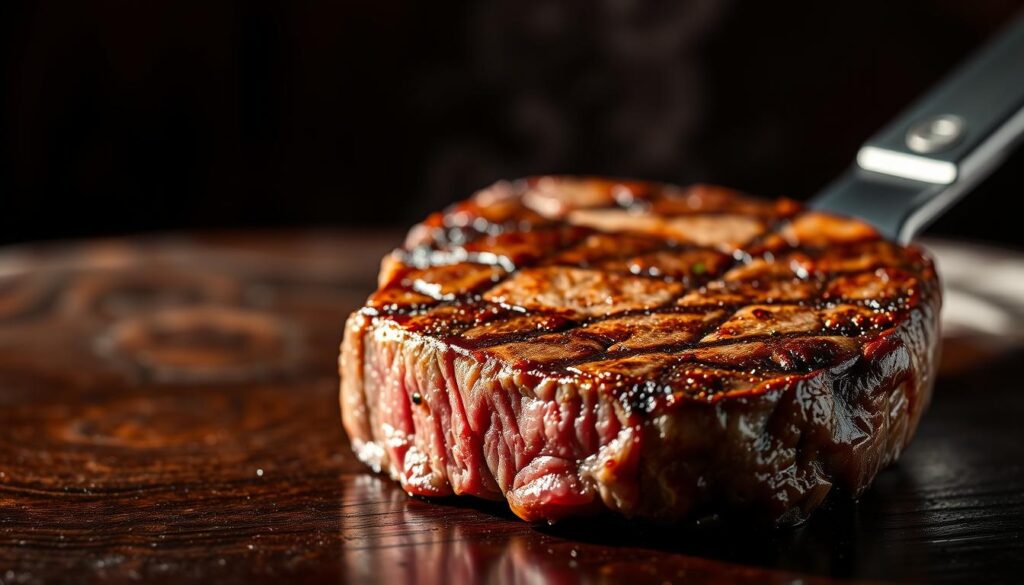
Step-by-Step Pan-Searing Instructions
To pan-sear teres major steak to perfection, follow these steps:
- Pat the steak dry with paper towels to remove excess moisture.
- Season the steak appropriately with your choice of seasonings.
- Heat the pan over high heat until it’s hot enough to sear the steak. You can test this by flicking a few drops of water onto the pan; if they sizzle and evaporate quickly, it’s ready.
- Add a small amount of oil with a high smoke point to the pan.
- Place the steak in the pan and cook for 3-4 minutes per side, depending on the thickness and your desired level of doneness.
- Use a thermometer to check for internal temperatures: 130°F – 135°F for medium-rare, 140°F – 145°F for medium.
- Once cooked, remove the steak from the pan and let it rest for a few minutes before slicing.
As Chef Gordon Ramsay once said, “The key to a great steak is in the resting. Let it sit, and let the juices redistribute.” This step is key for a tender and flavorful steak.
By following these steps and choosing the right pan, you can achieve a perfectly pan-seared teres major steak that’s sure to impress.
Roasting Teres Major Steak
Roasting teres major steak is a simple yet effective way to bring out its rich flavor and tender texture. This method allows for even cooking. It results in a beautifully browned crust on the outside, while keeping the inside juicy.
Oven Preparation
To roast teres major steak, start by preheating your oven to a temperature between 375°F and 425°F. The exact temperature may depend on your preferred level of doneness and the thickness of the steak. Positioning the oven rack in the middle is generally recommended for even heating. If your oven has a convection setting, you can use it to potentially reduce cooking time and enhance browning.
Equipment Needed: A roasting pan, a wire rack to elevate the steak for air circulation, and a meat thermometer are essential. You can choose to roast the steak covered or uncovered, depending on your preference for browning.
Cooking Time and Internal Temperatures
Cooking time will vary based on the steak’s thickness and your desired level of doneness. Use the following temperature chart as a guide:
| Level of Doneness | Internal Temperature (°F) | Internal Temperature (°C) |
|---|---|---|
| Rare | 130-135 | 54-57 |
| Medium Rare | 135-140 | 57-60 |
| Medium | 140-145 | 60-63 |
| Medium Well | 145-150 | 63-66 |
| Well Done | 150+ | 66+ |
It’s important to use a meat thermometer to check the internal temperature, as cooking times can vary. Remove the steak from the oven when it reaches 5°F below your desired doneness, as it will continue to cook slightly after removal.
Tip: Always let the steak rest for a few minutes before slicing. This allows the juices to redistribute, ensuring a tender and flavorful experience.
Seasoning the Teres Major Steak
Seasoning is key to bringing out the best in your teres major steak. The right seasonings can make the meat taste amazing. We’ll look at simple seasoning methods and marinades that go well with the steak.
Simple Seasoning Suggestions
Start with salt and pepper for a classic taste. Salting before cooking tenderizes the steak. Salting after cooking adds flavor. Freshly ground pepper adds a sharpness that complements the beef.
Try different salts like kosher or sea salt for unique flavors. Kosher salt is good for seasoning before cooking. Flaky sea salt adds a delicate touch when sprinkled over the steak before serving.
Adding herbs and spices can also enhance the flavor. Garlic powder, onion powder, paprika, and dried herbs like thyme or rosemary are great choices. These ingredients add to the beef’s flavor without overpowering it. A good seasoning mix is 2 parts salt, 1 part black pepper, and 1 part garlic powder.
Marinades That Pair Well
Marinades can add depth and complexity to your teres major steak. Here are some marinade recipes that work well:
- Red Wine and Herb Marinade: Mix 1 cup red wine, 2 cloves minced garlic, 1 tablespoon olive oil, and 1 tablespoon chopped fresh rosemary. Marinate for 2-3 hours.
- Balsamic Marinade: Combine 1/2 cup balsamic vinegar, 1/4 cup olive oil, 2 cloves minced garlic, and 1 teaspoon dried thyme. Marinate for 1-2 hours.
- Asian-Inspired Soy-Ginger Marinade: Blend 1/2 cup soy sauce, 1/4 cup olive oil, 2 cloves minced garlic, and 1 tablespoon grated ginger. Marinate for 1-2 hours.
- Latin-Inspired Citrus-Garlic Marinade: Mix 1/2 cup freshly squeezed orange juice, 1/4 cup olive oil, 2 cloves minced garlic, and 1 teaspoon dried oregano. Marinate for 1-2 hours.
- Mediterranean Olive Oil-Herb Marinade: Combine 1/2 cup olive oil, 1/4 cup chopped fresh parsley, 2 cloves minced garlic, and 1 teaspoon lemon zest. Marinate for 1-2 hours.
When marinating, keep it in the fridge and avoid cross-contamination. The acidity in marinades tenderizes the steak. Oils and aromatics add flavor.
As “The Joy of Cooking” says, “A good marinade can make even the most tender cuts of meat more flavorful.” This is true for teres major steak, which gets extra flavor without needing long marination times.
Sides to Serve with Teres Major
Looking for the perfect sides for your teres major steak? We’ve got you covered. From classic to creative, these options will make your meal unforgettable. The right sides can really bring out the flavor of the steak.
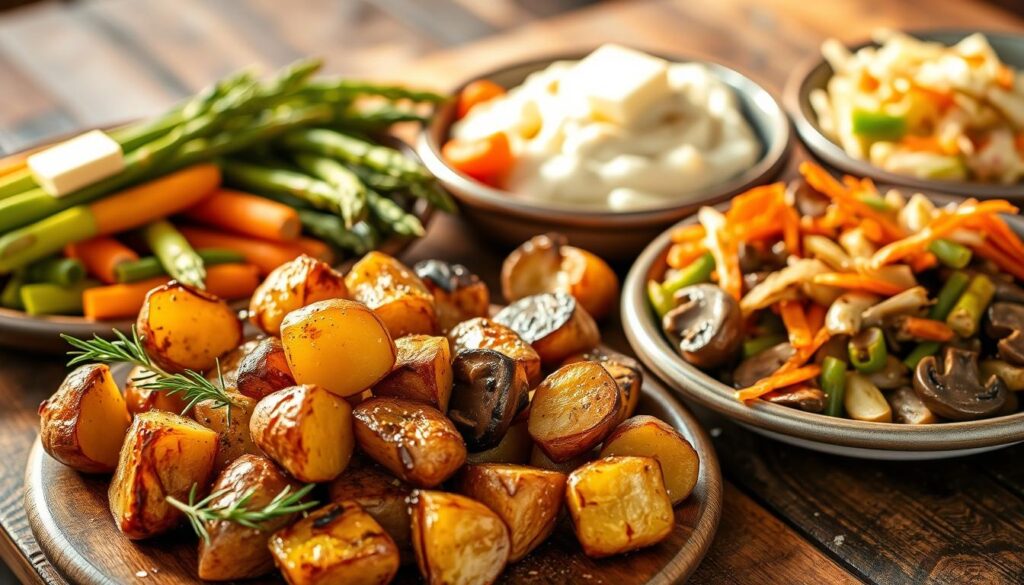
Classic Sides and Pairings
Classic steakhouse sides are loved for a reason. Creamy mashed potatoes pair beautifully with the tender beef teres major. Other favorites include roasted potatoes, grilled asparagus, creamed spinach, and sautéed mushrooms. They all offer a great mix of flavors and textures.
When it comes to drinks, red wines like Cabernet Sauvignon, Merlot, or Malbec are perfect. They complement the steak’s taste. For a simple recipe, just season your sides as you like and cook them at the right time.
- Creamy Mashed Potatoes: Boil diced potatoes until tender, then mash with butter, milk, and seasonings.
- Grilled Asparagus: Brush asparagus with olive oil, season with salt and pepper, and grill until tender.
- Creamed Spinach: Sauté chopped onions and garlic, add spinach and heavy cream, and simmer until thickened.
Creative Side Dishes Ideas
Want to try something new? There are many creative sides that go great with teres major steak. Try farro with roasted vegetables or wild rice pilaf for a grain-based option. Or, go for cauliflower puree or charred Brussels sprouts with bacon for a lighter taste.
For a unique twist, try Chimichurri roasted potatoes or miso-glazed eggplant. These sides not only match the steak but also add excitement to your meal.
Need to make sides for different diets? No problem. Use gluten-free grains or vegan alternatives to traditional dairy. This way, everyone can enjoy a great meal.
- Farro with Roasted Vegetables: Cook farro according to package instructions, then toss with roasted vegetables and a drizzle of olive oil.
- Charred Brussels Sprouts with Bacon: Toss Brussels sprouts with olive oil, salt, and pepper, and grill until charred. Crumble bacon on top before serving.
Serving Your Teres Major Steak
Serving teres major steak is an art that combines presentation, slicing, and timing. It creates a memorable dining experience. The way you present your steak can elevate the dining experience, making it not just about the taste but also about the visual appeal.
Presentation Tips
To present your teres major steak beautifully, consider the use of negative space on the plate. This means not overcrowding the plate with too many elements, allowing the steak to be the focal point. Color theory also plays a significant role; choose side dishes that create a visual contrast with the steak. For instance, if the steak is browned, a vibrant green vegetable like asparagus or broccoli can add a pop of color to the plate.
When it comes to garnishing, options like fresh herbs (such as parsley or thyme), compound butter coins, or a light sauce drizzled artfully can complement the steak without overpowering it. The choice of plate is also important; a warm plate can keep the steak at the right temperature for longer.
Slicing and Serving Suggestions
Properly slicing your teres major steak is key for both texture and presentation. It’s essential to identify the grain direction and slice perpendicular to it to achieve maximum tenderness. The ideal slice thickness is typically between ¼ to ½ inch, as this ensures the steak remains juicy and retains its temperature.
| Slice Thickness | Texture Outcome | Temperature Retention |
|---|---|---|
| ¼ inch | Tender, juicy | Excellent |
| ½ inch | Balanced texture | Good |
| ¾ inch or more | Less tender | Fair |
Whether to slice the entire steak before serving or present it whole and slice at the table depends on the dining scenario. For formal dinners, slicing at the table can be more elegant. For casual gatherings, slicing beforehand can be more practical.
To maintain the serving temperature, consider pre-warming your plates and serving the steak immediately after slicing. For a more formal presentation, individual plating is recommended. Family-style service is perfect for casual meals.
Storing Leftover Teres Major Steak
To keep your Teres Major steak fresh, follow these storage and reheating tips. Proper storage is key to keeping your steak quality and safe.
Cooling and Storage Techniques
First, cool the steak down to prevent bacteria growth. Let it sit at room temperature for about 30 minutes. Then, wrap it tightly in plastic wrap or foil, or use an airtight container.
For short-term storage, refrigeration works well. Store the steak in the fridge for up to 3-4 days. Place it in the coldest part, usually the bottom shelf.
For longer storage, freeze your Teres Major steak. Wrap it tightly in plastic or foil, or use a vacuum sealer. Label it with the date and store it at 0°F (-18°C) or below. Frozen steak can last 2-3 months for best quality.
| Storage Method | Duration | Notes |
|---|---|---|
| Refrigeration | 3-4 days | Store in airtight containers or wrap tightly. |
| Freezing | 2-3 months | Use vacuum sealing or tight wrapping to prevent freezer burn. |
Reheating Methods
There are several ways to reheat your Teres Major steak. Using a sous vide machine or a low-temperature oven is gentle. Bring the steak to room temperature, then heat it at around 250°F (120°C) until warmed through.
Another method is the stovetop-and-oven combination. Sear the steak briefly in a hot pan, then finish it in a low oven. You can also use the steam-and-sear technique by creating steam in a covered pan before uncovering to restore some exterior crispness.
While microwave reheating is generally not recommended, it can be done if you’re short on time. Use a lower power setting and check the steak frequently to avoid overheating.
“The art of cooking is not just about following a recipe; it’s about understanding the science behind it and applying that knowledge to achieve perfection.”
By following these storage and reheating guidelines, you can enjoy your leftover Teres Major steak almost as much as when it was freshly cooked. Whether you’re looking to preserve its tenderness or simply want to enjoy it again, these methods will help you achieve the best results.
Common Mistakes to Avoid
Cooking teres major steak well is more than just following a recipe. It’s about avoiding common mistakes. Two big errors are overcooking your steak and skipping the resting step. Both can ruin your meal.
Overcooking Your Steak
Overcooking is a big mistake when cooking teres major steak. This cut can become tough and dry if cooked too long. It’s lean, so it cooks quickly. Signs of overcooking include shrinkage, firmness, and a grayish color inside.
To avoid overcooking, use a meat thermometer. Understand carryover cooking and follow timing guidelines. Different cooking methods affect doneness, so adjust as needed. For example, grilling teres major requires careful heat management.
When cooking grilled teres major or any other way, watch closely. If you overcook, try slicing it thinly against the grain. This can make it more tender.
Skipping the Resting Step
Resting your teres major steak is key. It lets juices spread evenly, making it juicy and flavorful. Resting time varies, usually 5 to 10 minutes for teres major.
To rest your steak right, cover it with foil to keep heat in. Don’t worry about it getting cold; resting on warmed plates helps. Check if it’s rested by feeling its firmness.
Avoiding these mistakes can greatly improve your meal. Whether cooking teres major or other premium cuts, paying attention to detail is essential.
Conclusion: Enjoying Teres Major Steak
Teres major steak is tender and flavorful, perfect for any meal. It’s great for everyday dinners or special events. You can grill teres major or pan-fry it, and it always turns out well.
To enjoy your beef teres major at its best, focus on cooking it right. Make sure it’s cooked just right and let it rest. Trying new teres major steak recipes and spices can make your dish stand out.
Keep exploring with teres major and try new flavors and marinades. This will improve your cooking and help you appreciate less common meats. It’s also better for the environment.
Working with teres major steak is a fun journey. You’ll get to try new things and share your creations with friends and family. Enjoy the learning and the tasty results that come with it.
FAQ
What is teres major steak, and where does it come from?
How do I identify teres major steak when shopping?
What are the health benefits of teres major steak?
How do I cook teres major steak to achieve the best results?
What’s the best way to season teres major steak?
How do I store leftover teres major steak?
What’s the best way to reheat leftover teres major steak?
Can I cook teres major steak to well-done?
How long should I let teres major steak rest after cooking?
What are some good side dishes to serve with teres major steak?
For more cooking tips, stay connected with us. We also recommend the cookbook Skinnytaste Simple: Easy, Healthy Recipes with 7 Ingredients or Fewer
For more Recipes about Steak ?
Did You try our recipe ?
There are no reviews yet. Be the first one to write one.
